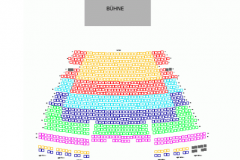Nutcracker - A Christmas Fairytale
Mo | Tu | We | Th | Fr | Sa | Su |
Was it all just a dream? Somewhere between illusion and reality, between day and night, Peter I. Tchaikovsky set his masterpiece. Like no other work, "The Nutcracker" embodies danced fantasy and a musical wonderland in one. Here you can dream, listen, watch – and be amazed! Against an enchanting backdrop, a poetic fairytale unfolds at the Prinzregententheater, made up of familiar and new elements, with Tchaikovsky's delightful music forming the foundation: A mix of ballet, colors, light, and even acrobatics transports the viewer into magical scenes, distant worlds, and snow-covered winter landscapes. The Mouse King and Sugar Plum Fairy, coffee, tea, and chocolate – they are all there, part of the familiar plot, which, like Tchaikovsky's picturesque musical ideas, is an indispensable component.
The fascinating combination of classical ballet and acrobatics lends "The Nutcracker" magical moments: objects whirl effortlessly across the stage; a dream figure in a mirror costume conjures up ethereal sounds from a glass orchestra to Tchaikovsky's music; a jester adds a special note to the lively scenes. The plot and characters are framed by familiar sounds: the Waltz of the Flowers, Dance of the Reed Flutes, Snowflake Waltz, Chinese Dance... a lovingly crafted masterpiece, whose details surprise and invite you to dream. Children are also welcome – after all, "The Nutcracker" remains a true Christmas fairytale classic.
Plot
Below is a synopsis based on the original 1892 libretto by Marius Petipa. The story varies from production to production, though most follow the basic outline. The names of the characters also vary. In the original Hoffmann story, the young heroine is called Marie Stahlbaum and Clara (Klärchen) is her doll's name. In the adaptation by Dumas on which Petipa based his libretto, her name is Marie Silberhaus. In still other productions, such as Balanchine's, Clara is Marie Stahlbaum rather than Clara Silberhaus.
Act I
Scene 1: The Stahlbaum Home
In Nuremberg, Germany on Christmas Eve in the 1820s, a family and their friends gather in the parlor to decorate the Christmas tree in preparation for the party. Once the tree is finished, the children are summoned.
When the party begins, presents are given out to the children. When the owl-topped grandfather clock strikes eight, a mysterious figure enters the room. It is Drosselmeyer— a councilman, magician, and Clara's godfather. He is also a talented toymaker who has brought with him gifts for the children, including four lifelike dolls who dance to the delight of all. He then has them put away for safekeeping.
Clara and her brother Fritz are sad to see the dolls being taken away, but Drosselmeyer has yet another toy for them: a wooden nutcracker doll, which the other children ignore. Clara immediately takes a liking to it, but Fritz accidentally breaks it. Clara is heartbroken, but Drosselmeyer fixes the nutcracker, much to everyone's relief.
During the night, after everyone else has gone to bed, Clara returns to the parlor to check on the nutcracker. As she reaches the small bed, the clock strikes midnight and she looks up to see Drosselmeyer perched atop it. Suddenly, mice begin to fill the room and the Christmas tree begins to grow to dizzying heights. The nutcracker also grows to life size. Clara finds herself in the midst of a battle between an army of gingerbread soldiers and the mice, led by their king.
The nutcracker appears to lead the gingerbread men, who are joined by tin soldiers, and by dolls who serve as doctors to carry away the wounded. As the seven-headed Mouse King advances on the still-wounded nutcracker, Clara throws her slipper at him, distracting him long enough for the nutcracker to stab him.
Scene 2: A Pine Forest
The mice retreat and the nutcracker is transformed into a human prince.[25] He leads Clara through the moonlit night to a pine forest in which the snowflakes dance around them, beckoning them on to his kingdom as the first act ends.
Act II
The Land of Sweets
Clara and the Prince travel to the beautiful Land of Sweets, ruled by the Sugar Plum Fairy in the Prince's place until his return. He recounts for her how he had been saved from the Mouse King by Clara and transformed back into himself. In honor of the young heroine, a celebration of sweets from around the world is produced: chocolate from Spain, coffee from Arabia, tea from China, and candy canes from Russia[31] all dance for their amusement; Marzipan shepherdesses perform on their flutes;[32] Mother Ginger has her children, the Polichinelles, emerge from under her enormous hoop skirt to dance; a string of beautiful flowers perform a waltz. To conclude the night, the Sugar Plum Fairy and her Cavalier perform a dance.
A final waltz is performed by all the sweets, after which the Sugar Plum Fairy ushers Clara and the Prince down from their throne. He bows to her, she kisses Clara goodbye, and leads them to a reindeer-drawn sleigh. It takes off as they wave goodbye to all the subjects who wave back.
In the original libretto, the ballet's apotheosis "represents a large beehive with flying bees, closely guarding their riches". Just like Swan Lake, there have been various alternative endings created in productions subsequent to the original.
Program and cast
A Christmas Fairytale
International Festival Ballet & Special Guests
Peter I. Tchaikovsky, Music
Marius Petipa, Libretto
Lev Ivanov, Choreography
Martin Jansons, Lighting Design
Alex Bogutsky, Production
Ivan Luzan, Direction
Thekla / Mackay, Storyteller (11:00 AM & 3:30 PM)
Prinzregententheater
The Prinzregententheater, or Prince Regent Theatre, is a theatre and opera house located at 12 Prinzregentenplatz in theBavarian city of Munich, Germany.
Initiated by Ernst von Possart, the theatre was built in the Prinzregentenstrasse as a festival hall for the operas of Richard Wagner near an area where a similar project of King Ludwig II had failed some decades before. Named after Luitpold, Prince Regent of Bavaria the building was designed by Max Littmann and opened 21 August 1901 with a production of "Die Meistersinger von Nürnberg" by Richard Wagner. Like the Bayreuth theatre, the auditorium was designed to Wagner’s specifications, however an amphitheater has replaced the loges.
After the destruction of the Nationaltheater during World War II, the Prinzregententheater housed the Bavarian State Operafrom 1944 to 1963 even though it also suffered damage during the war which was not repaired until 1958. Since its renovation in 1988, the Prinzregententheater, with 1122 seats, has served also for the Bavarian Staatsschauspiel and now houses the Bavarian Theatre Academy founded by August Everding. Another theatre in the building, the Akademietheateror Academy Theatre, seats 300.
The Prince Regent theater is reached very well both by car and by public transportation MVV.
With the MVV (Munich Transport)
Subway: U4 Prinzregentenplatz
Bus: Lines 54, 100 Prince Regent Place

 EN
EN DE
DE IT
IT FR
FR ES
ES RU
RU JP
JP RO
RO
 Seating plan
Seating plan 
